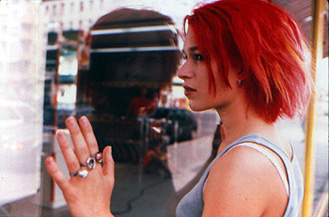|
|
Viking Night: Run Lola RunBy Bruce HallApril 7, 2010
Lola and Manni are deeply in love, yet their trust has been shattered by the debacle of the failed money exchange and the possibility that death is about to separate them. Lola worries that Manni loves having a girlfriend more than he loves having her. Manni is a needy fatalist, and wonders whether Lola would even mourn him if he did die. Each carries this nervous agitation alongside their panic in each of the three runs, and the effect it has on their judgment ultimately determines how it ends each time. They are given three chances to come to the right conclusions and ultimately discover that they must gather their wits and lean on each other in order to survive not just this ordeal, but as a couple. It's really these two short scenes in the first third of the movie that unify the plot, justify the tension of the story and Lola and Manni a soul. Run Lola Run is somewhat coy about whether or not this story takes place within a surreal environment where the characters literally re-live the same event repeatedly (a la Groundhog Day) or whether it simply offers us hypothetical outcomes, leaving it for us to decide (a la Sliding Doors). There answer is there if you watch for it, but that's probably less relevant than the question posed – how would you change your life, if you could? Each time the scenario plays out Lola and Manni learn something about themselves and about their shared little world, refining their approach as well as their personal relationship. At a brisk 80 minutes, the film is barely longer than the season finale of your favorite television show. But for those observant enough to catch it all on the first viewing this short film is full of surprising depth as well as energy, color, fun and excitement enough for a feature half again as long. It truly is one of the rare films I can say I occasionally enjoy watching over again, as there's something new to observe each time, and it always feels as fresh and fun as it did the first time. I just wish I could say that old Star Trek episode has aged as well.
|

|
|
|

|
Friday, November 1, 2024
© 2024 Box Office Prophets, a division of One Of Us, Inc.


